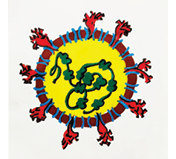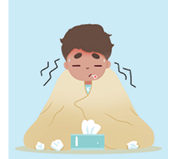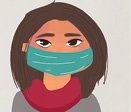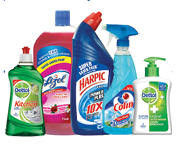by Indian Scientists’ Response to CoViD-19
A majority of COVID19 cases involve a cough and fever, much like a flu. If someone in your family shows these symptoms, they could be a COVID19 case. Individuals who are normally in good health usually get better on their own in 3-5 days. The patient will need care and support to ensure that the virus does not spread within the household or beyond.

A majority of COVID19 cases involve a cough and fever, much like a flu. If someone in your family shows these symptoms, they could be a COVID19 case. Inform the nearest health centre, your private doctor or call 011-23978046. Depending upon your symptoms, they may ask you to stay at home or refer you to a designated government or private hospital or to a testing centre.
Individuals who are normally in good health usually get better on their own in 3-5 days. In the meantime, the patient should stay at home for 14 days after they stop showing symptoms. During this period, the patient will need care and support to ensure that the virus does not spread within the household or beyond.

First, it is ideal to confine the patient to a single designated room or part of a room. Next, assign one family member as the caregiver for the patient throughout the course of the illness. If possible, the caregiver should not themselves be a high risk person (elderly, very young or with a preexisting condition). This person will provide most of the care for the patient during the course of the illness.

Mask use is advised for both the patient and the caregiver. If possible, the patient should use an N95 at all times. Note that the masks are not reusable and must be replaced every 6-8 hours. Dispose the mask by burning or deep burying. If this is not possible, the patient can use a reusable cloth mask. The caregiver must use a reusable cloth mask if they have to leave the house. It is best that the caregiver also does not leave the house and observes a 14 day quarantine post recovery of the patient.

During the time that the patient is unwell (and for 14 days after they stop showing symptoms), do not entertain visitors at home. There could be viruses on various surfaces and cloth that the patient comes in contact with that other members of the household should protect themselves from. Do not share a bed or any other personal items with the patient such as toothbrushes, towels, bedsheets, utensils etc.
If possible, designate a separate bathroom/toilet for the patient. If the toilet is shared, make sure to also disinfect other items that the patient may touch daily. In western toilets, put the toilet lid down before flushing and wipe the toilet seat. If the toilet is an Indian style toilet, wipe down all other surfaces that the patient might have touched (mugs / taps etc) after use. Keep a mug with soapy water and a sponge/cloth to be easily used by the patient (or caregiver if needed) to wipe off any surface that the patient touches while using the toilet.

Clean and disinfect other frequently touched surfaces (e.g. bed frames, tables etc.) daily with soapy water / 1% Sodium Hypochlorite Solution (bleach 1:10) including toilets. Wash clothes and other bedsheets used by the patient separately, if possible, using common household detergent.
To be extra cautious, the caregiver can use disposable gloves when cleaning the surfaces or handling soiled bedsheets but washing your hands properly with water before and after should suffice. If the patient uses a shared smartphone or other touch device, disinfect it with alcohol between users. Everyone in the household should avoid direct skin contact with the patient. If the patient is infirm or very unwell and needs physical contact the caregiver should clean themself properly with soap and water before and after the attend to the patients physical needs. While there isn’t conclusive evidence that pets can get the virus, it is best if the patient avoids contact with pets that other family members touch, since the virus can be transferred on the pets fur/skin.

Other members of the household should try to quarantine (https://www.mohfw.gov.in/pdf/Guidelinesforhomequarantine.pdf) and stay home as much as possible. It’s also advisable to inform people who were in close contact with the patient in the last 14 days to quarantine themselves.
Other than that, it’s absolutely OK to talk to them on the phone or interact with them in any other way at a distance of 2m. Other members in the household should also help ensure that the patient (and caregiver) have enough clean food and water and a healthy and happy environment.
Every attempt has been made for scientific accuracy; in case any inaccuracies are found, please bring it to our notice at indscicov@gmail.com.
Image credits:
Anushka, Saynatan, Arpitha, Unsplash, Rabin